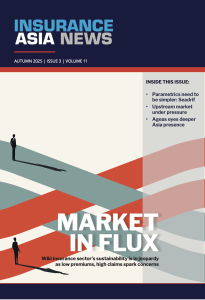SIRC: Reinsurers continue to be bottom-line focused: AM Best
November 6 2025 by Joana Nguyen
What’s your observation on the premium growth and underwriting losses in 2025 as well as outlook for 2026?
Christie Lee: I don’t think premium growth is the main focus for reinsurers in Asia. Even though the market is softening, reinsurers have been very bottom-line focused. In terms of the underwriting performance, so far 2025, it is still quite good.
Major cat losses have been quite benign and manageable, with large cat losses probably coming from Taiwan earthquake and also the Myanmar earthquake that hit Thailand.
As of first half in Q3, according to publicly announced results, both topline and the bottomline have improved.
So reinsurers are delivering good operating performance in 2025. We expect there will be rate reduction in 1.1. However, overall, the full-year performance will still highly depend on cat activities throughout next year.
There have been comments that reinsurance growth in Asia, in terms of premiums and limits purchased, is not as great as expected. What’s your view on this?
CL (pictured, below): In the North Asia market, particularly greater China, Japan and Korea, the top-line growth and risk-adjusted, exposure growth are not as quick as Southeast Asia.
 This is because they are more mature markets, with economic growth in Japan and Korea relatively stagnant, while China has also slowed down, which affects the property side. However, we see rising reinsurance demand from some other areas, such as offshore wind energy in Taiwan because of government push for green energy.
This is because they are more mature markets, with economic growth in Japan and Korea relatively stagnant, while China has also slowed down, which affects the property side. However, we see rising reinsurance demand from some other areas, such as offshore wind energy in Taiwan because of government push for green energy.
Victoria Ohorodnyk: Southeast Asia, Australia and New Zealand, meanwhile, are a bit of a mixed bag. For example, results of national reinsurers in a lot of these countries have not actually been as good as the global trends due to impacts of the secondary perils. So, they have been growing more cautiously and selectively.
So on a risk-adjusted basis, the growth still is in high single digits to low teens on average. So what we’re definitely seeing is that the prudency is still being maintained, despite the current softening conditions. They have learned their lessons from past poor performances and do not want to see deteriorating results.
There have been a lot of regulatory changes happening related to solvency regimes and RBC in APAC, how do you see that impacts the demand of reinsurance?
VO: A lot of primary companies and reinsurers are still reacting and digesting some of these ongoing regulatory changes. If we take Indonesia, for example, with the stringent capital requirements, we are expecting to see more consolidation in markets like that.
On the flip side of that, stronger regulatory regimes attract more international capacity to the markets. So the local players will need to up their game to be competitive with the international players.
The transition period might be challenging for local players, but once they get to the other side, that would make for a better, stronger market.
CL: For Japan, the consolidation happening within MS&AD between Mitsui Sumitomo Insurance (MSI) and Aioi Nissay Dowa Insurance (ADI) means they will pull together a larger capital size. Overall, we’re expecting Japanese carriers will have stronger capability to retain more underwriting risk in their own books. And perhaps the demand on reinsurance might come down on the combined basis.
We have actually started seeing this this year. We expect the same effect by 2026 when the two large MS&AD entities combined together.
Japan property treaties are one of the largest in the world. So if there’s a premium reduction from Japan, reinsurers might have to look elsewhere for filling the top line gap.
VO: I would say the themes are largely quite similar in Australia. The demand for reinsurance, I think, can only increase with climate risks. But a lot of the regulatory developments are still ongoing. So it’s sort of a wait and see for now.
-
QBE | Elevating customer experience, humanising claims: QBE Asia’s ‘Solutions in a Box’
Vastly improving turnaround times and personalising service delivery, QBE Asia’s award-winning, end-to-end bundled claims solutions is a game-changer for the insurance industry.
-
Beazley | What does cyber protection look like from day 1 to day 600 and beyond?
Cybersecurity is no longer just an IT concern, but a governance issue that belongs on the boardroom agenda.
-
Sedgwick | Preparing for the next storm
Insurance industry needs to recalibrate, invest in innovation and strengthen systems, talent and data practices.
-
Peak Re | From climate modelling to market opportunity: Forging a new clarity on Southeast Asia’s climate risk
Southeast Asia's protection gap: a crisis of clarity, not just capital

